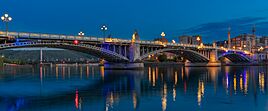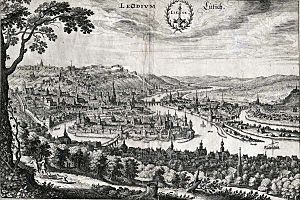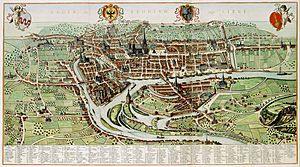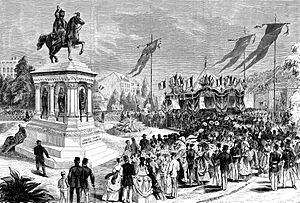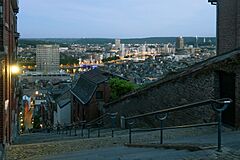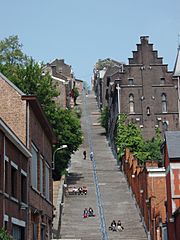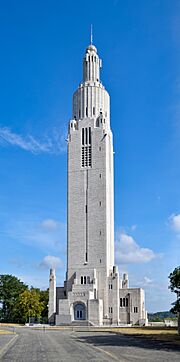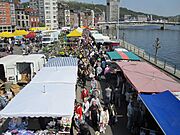Liège facts for kids
Quick facts for kids
Liège
|
|||
|---|---|---|---|
|
Prince-Bishops' Palace
Royal Opera of Wallonia
Liège-Guillemins
Collegiate Church of St. Bartholomew
Le Perron
Bridge of Fragnée over the river Meuse
|
|||
|
|||
| Country | Belgium | ||
| Region | Wallonia | ||
| Community | French Community | ||
| Province | Liège | ||
| Arrondissement | Liège | ||
| Area | |||
| • Total | 69.39 km2 (26.79 sq mi) | ||
| Population
(January 2010)
|
|||
| • Total | 192,504 | ||
| • Density | 2,774.23/km2 (7,185.2/sq mi) | ||
| Demographics | |||
| • Foreigners | 16.05% (7 January 2005) | ||
| Postal codes |
4000–4032
|
||
| Area codes | 04 | ||
Liège is a lively city and municipality in Wallonia, a region in Belgium. It is the capital of the Belgian province of Liège.
The city is located in the beautiful valley of the Meuse River, in eastern Belgium. It is close to the borders of the Netherlands (about 33 km from Maastricht) and Germany (about 53 km from Aachen). In Liège, the Meuse River meets the Ourthe River. This city is a key part of the sillon industriel, which was once the industrial heart of Wallonia. Today, it remains the main economic and cultural center of the region.
The municipality of Liège includes several smaller areas. These are Angleur, Bressoux, Chênée, Glain, Grivegnée, Jupille-sur-Meuse, Liège itself, Rocourt, and Wandre. In November 2012, Liège had about 198,280 people living there. The larger metropolitan area, which includes nearby towns, covers 1,879 square kilometers. On January 1, 2008, it had a total population of 749,110. This area includes 52 municipalities, such as Herstal and Seraing. Liège is the third largest urban area in Belgium, after Brussels and Antwerp. It is also the fourth largest municipality. The city is part of the Meuse-Rhine Euroregion.
Contents
The Name of Liège
The name Liège comes from an old Germanic word, *liudik-. This word means "people." You can find similar words in other languages like Dutch, Polish, Czech, and German.
Before 1946, the city's name was spelled Liége, with a different accent mark.
In French, Liège is often called la cité ardente, which means "the fervent city." This nickname started around 1905. It first referred to the city's history of fighting against rulers from Burgundy. Later, it also described the city's strong economic growth during the Industrial Revolution.
Liège Through Time
Early History of Liège
Even though people lived here in Roman times, the first records of Liège are from 558. Back then, it was known as Vicus Leudicus. Around 705, Saint Lambert of Maastricht helped spread Christianity in the area. This shows that some older religious practices were still around until the early 700s.
Saint Lambert was murdered in Liège and became a martyr. To honor him, his successor, Hubertus (who later became Saint Hubert), built a church. This church was near the bishop's home and became the true beginning of the city.
A few centuries later, Liège became the capital of a prince-bishopric. This was a special area ruled by a prince-bishop, and it lasted from 985 to 1794. The first prince-bishop, Notger, made Liège a very important center for learning and religion. It stayed culturally important throughout the Middle Ages. Even Pope Clement VI hired musicians from Liège for his court. The city was famous for its many churches, with the oldest, St Martin's, dating back to 682. Although it was technically part of the Holy Roman Empire, Liège was largely independent.
Medieval and Early Modern Liège
Liège's location made it a frequent target for armies and rebellions over the centuries. It was fortified early on with a castle on a steep hill overlooking the city. During the medieval period, three important women from the Liège region contributed to Christian spirituality: Elizabeth Spaakbeek, Christina the Astonishing, and Marie of Oignies.
In 1345, the people of Liège rebelled against their ruler, Prince-Bishop Engelbert III de la Marck. They defeated him in a battle near the city. Soon after, Liège developed a unique political system. The city's 32 guilds shared control of the government. Everyone in a guild could take part, and each guild had an equal say. This made it one of the most democratic systems in the Low Countries at the time. This democratic spirit continued in Liège for a long time.
At the end of the Liège Wars, there was a rebellion against rule from Burgundy. In 1468, Duke Charles the Bold of Burgundy, along with King Louis XI of France, captured and largely destroyed the city after a tough siege. This rebellion is a big part of Sir Walter Scott's 1823 novel Quentin Durward.
The Prince-Bishopric of Liège was part of the Holy Roman Empire. After 1477, this empire came under the rule of the Habsburg family. The time of prince-bishop Érard de La Marck (1506–1538) marked the beginning of the Renaissance in Liège.
During the Counter-Reformation, the diocese of Liège was divided. It slowly lost its power as a regional force. By the 17th century, the bishopric of Liège was often ruled by second sons of the Bavarian royal family, the Wittelsbachs. For example, Ernest of Bavaria began ruling in 1581. Bavarian princes also ruled other bishoprics in the Holy Roman Empire.
In 1636, during the Thirty Years' War, the city was under siege by Imperial forces. The army, mostly made up of hired soldiers, badly plundered the surrounding area during the siege.
From the 1700s to World War I
The Duke of Marlborough captured Liège from the Bavarian prince-bishop and his French allies in 1704. This happened during the War of the Spanish Succession.
In the mid-1700s, new ideas from French thinkers became popular. Bishop François-Charles de Velbrück (1772–84) encouraged these ideas. This led to the Liège Revolution, which began on August 18, 1789. It created the Republic of Liège, but counter-revolutionary forces soon invaded in 1791.
During the French Revolution campaigns of 1794, the French Revolutionary Army took the city. They brought a strong anti-religious government and destroyed St. Lambert's Cathedral. The end of the Prince-Bishopric of Liège was made official in 1801. This was part of an agreement signed by Napoléon Bonaparte and Pope Pius VII.
France lost the city in 1815. The Congress of Vienna gave Liège to the United Kingdom of the Netherlands. Dutch rule only lasted until 1830. Then, the Belgian Revolution led to an independent Belgium, which included Liège. After this, Liège quickly grew into a major industrial city. It became one of Europe's first big steel-making centers. The Walloon Jacquerie of 1886 saw large worker protests. Many troops were called in to stop the unrest, which spread across the industrial region.
Liège's defenses were rebuilt in the 1880s by Henri Alexis Brialmont. A chain of twelve forts was built around the city for protection. These forts were a big problem for the Imperial German Army in 1914. Germany's war plan relied on moving quickly through the Meuse valley and the Ardennes into France. The German invasion of Belgium on August 5, 1914, quickly reached Liège. The city was defended by 30,000 troops under General Gérard Leman in the Battle of Liège.
The forts first held off General Alexander von Kluck's German First Army of about 100,000 men. But they were destroyed by five days of heavy artillery attacks. This included huge German 42 cm Big Bertha howitzers. One direct hit caused a massive explosion, leading to the surrender of the Belgian forces. The Belgian resistance was shorter than planned, but the twelve days of delay helped slow down the German invasion of France. The city was then occupied by the Germans until the end of the war. Liège received the Légion d'Honneur for its brave resistance in 1914.
From World War II to Today
The Germans returned in 1940. This time, they took the forts in just three days. Many Jewish people were saved thanks to the kind local population. Many Jewish children and refugees were hidden in the city's monasteries. Liège was freed by the British Second Army in September 1944.
After the war, there was a big debate about King Leopold III. Many people thought he had cooperated with the Germans during the war. In July 1950, André Renard, a leader of the Liègian FGTB, started a big strike. This strike eventually led to Leopold giving up his throne.
Liège then faced a decline in its industries, especially coal and later steel. This caused high unemployment and social problems. During the 1960-1961 Winter General Strike, upset workers caused damage, including to the central railway station, Guillemins. The unrest was so strong that "army troops had to clear obstacles to move forward. Streets were dug up. Liège saw the worst fighting on January 6, 1961."
Liège is also known as a city with a strong socialist history. In 1991, a powerful Socialist leader, André Cools, was involved in a political scandal. This scandal affected the Socialist Party and the Belgian Federal Government.
In recent years, Liège has shown signs of economic improvement. This is due to open borders within the European Union, rising steel prices, and better management. Several new shopping centers have been built, and many repairs have been done.
Liège Weather
Liège has a maritime climate. This means it is influenced by mild sea winds from the Gulf Stream. Because of this, Liège has very mild winters for its location, especially compared to places like the Russian Far East or Quebec. Summers are also made milder by the sea air. Average temperatures are similar to places as far north as Scandinavia. However, because it is inland, Liège has a relatively quick change from winter to spring.
| Climate data for Liège (1991−2020 normals, extremes 1949−present) | |||||||||||||
|---|---|---|---|---|---|---|---|---|---|---|---|---|---|
| Month | Jan | Feb | Mar | Apr | May | Jun | Jul | Aug | Sep | Oct | Nov | Dec | Year |
| Record high °C (°F) | 15.3 (59.5) |
20.0 (68.0) |
24.4 (75.9) |
28.9 (84.0) |
32.8 (91.0) |
34.9 (94.8) |
39.5 (103.1) |
36.1 (97.0) |
33.3 (91.9) |
26.3 (79.3) |
21.3 (70.3) |
16.1 (61.0) |
39.5 (103.1) |
| Mean maximum °C (°F) | 11.9 (53.4) |
13.4 (56.1) |
18.1 (64.6) |
22.9 (73.2) |
26.8 (80.2) |
30.3 (86.5) |
32.1 (89.8) |
31.6 (88.9) |
26.6 (79.9) |
21.8 (71.2) |
16.3 (61.3) |
12.4 (54.3) |
34.0 (93.2) |
| Mean daily maximum °C (°F) | 6.4 (43.5) |
7.3 (45.1) |
11.1 (52.0) |
15.4 (59.7) |
19.0 (66.2) |
22.0 (71.6) |
24.1 (75.4) |
23.9 (75.0) |
20.1 (68.2) |
15.4 (59.7) |
10.2 (50.4) |
6.8 (44.2) |
15.2 (59.4) |
| Daily mean °C (°F) | 3.7 (38.7) |
4.2 (39.6) |
7.1 (44.8) |
10.4 (50.7) |
14.2 (57.6) |
17.3 (63.1) |
19.3 (66.7) |
19.0 (66.2) |
15.6 (60.1) |
11.7 (53.1) |
7.4 (45.3) |
4.4 (39.9) |
11.2 (52.2) |
| Mean daily minimum °C (°F) | 1.1 (34.0) |
1.1 (34.0) |
3.1 (37.6) |
5.5 (41.9) |
9.4 (48.9) |
12.5 (54.5) |
14.5 (58.1) |
14.1 (57.4) |
11.1 (52.0) |
8.0 (46.4) |
4.5 (40.1) |
2.0 (35.6) |
7.2 (45.0) |
| Mean minimum °C (°F) | −6.7 (19.9) |
−5.9 (21.4) |
−3.3 (26.1) |
−0.8 (30.6) |
2.7 (36.9) |
6.7 (44.1) |
9.3 (48.7) |
9.1 (48.4) |
6.1 (43.0) |
1.5 (34.7) |
−1.8 (28.8) |
−5.0 (23.0) |
−9.2 (15.4) |
| Record low °C (°F) | −19.8 (−3.6) |
−18.8 (−1.8) |
−16.7 (1.9) |
−5.8 (21.6) |
−1.7 (28.9) |
1.2 (34.2) |
2.7 (36.9) |
4.5 (40.1) |
0.0 (32.0) |
−4.8 (23.4) |
−8.9 (16.0) |
−16.1 (3.0) |
−19.8 (−3.6) |
| Average precipitation mm (inches) | 72.2 (2.84) |
65.9 (2.59) |
60.1 (2.37) |
52.7 (2.07) |
67.7 (2.67) |
78.6 (3.09) |
78.9 (3.11) |
85.2 (3.35) |
67.5 (2.66) |
67.4 (2.65) |
68.3 (2.69) |
89.1 (3.51) |
853.7 (33.61) |
| Average precipitation days (≥ 1.0 mm) | 13.3 | 12.2 | 11.7 | 9.5 | 10.7 | 11.0 | 10.8 | 10.7 | 9.9 | 11.1 | 12.7 | 15.3 | 138.8 |
| Mean monthly sunshine hours | 61 | 79 | 130 | 181 | 203 | 208 | 214 | 204 | 159 | 116 | 67 | 49 | 1,670 |
| Source 1: Royal Meteorological Institute | |||||||||||||
| Source 2: Extremes Infoclimat | |||||||||||||
People of Liège
On January 1, 2013, Liège had a population of 197,013 people. The larger metropolitan area has about 750,000 residents. Most people in Liège speak French. There are also smaller groups who speak German and Dutch. Like the rest of Belgium, the number of people from other countries has grown a lot since the 1990s. The city is now home to many immigrants from Algeria, Morocco, Turkey, and Vietnam. Liège also has a notable Afro-Belgian community.
The city is a big center for education in Belgium. There are 42,000 students attending over 24 schools. The University of Liège, which started in 1817, has 20,000 students.
| Group of origin | Year | |
|---|---|---|
| 2023 | ||
| Number | % | |
| Belgians with Belgian background | 85,622 | 43.83% |
| Belgians with foreign background | 70,590 | 36.14% |
| Neighboring country | 4,999 | 2.56% |
| EU27 (excluding neighboring country) | 19,077 | 9.77% |
| Outside EU 27 | 46,514 | 23.81% |
| Non-Belgians | 39,134 | 20.03% |
| Neighboring country | 5,077 | 2.6% |
| EU27 (excluding neighboring country) | 11,089 | 5.68% |
| Outside EU 27 | 22,968 | 11.76% |
| Total | 195,346 | 100% |
Exploring Liège: Main Sights
- The huge palace of the Prince-Bishops of Liège stands on Place St Lambert. This is where the old St. Lambert's Cathedral used to be before the French Revolution. The oldest parts of the palace are from the 16th century. You can visit an archaeological exhibit, the Archéoforum, under Place St Lambert.
- The perron on Place du Marché was once a symbol of justice. Now, it is the symbol of the city. It stands in front of the city hall, which was built in the 17th century.
- Liège has seven important churches called collegiate churches:
- St Paul's, which became Liège Cathedral in 1802. It holds a treasury and Saint Lambert's tomb.
- St James (became a collegiate church after St Peter's Collegiate Church was taken down in 1811). It is built in the flamboyant gothic style. It has an early Renaissance porch and statues by Liège sculptor Jean Del Cour. Saint-Jacques has 29 special seats called misericords from the 14th century.
- St Martin
- St Denis
- St John the Evangelist
- Holy Cross
- St Bartholomew
- The main museums in Liège are:
- La Boverie (Fine Arts Museum)
- Museum of Walloon Life
- Museum of Walloon Art & Religious Art (Mosan art)
- The Grand Curtius Museum is a beautiful 17th-century mansion by the Meuse River. It has collections of Egyptology, weapons, archaeology, fine arts, and religious art.
- Other interesting places include the historic city center (the Carré), the Hors-Château area, the Outremeuse area, and the parks along the Meuse River. You can also visit the Citadel, the 374 steps of "Montagne de Bueren" leading to the Citadel, and the 'Médiacité' shopping mall. The Interallied Memorial of Cointe is a complex with a church and an Art Deco tower. It offers a great view of the city. The Liège-Guillemins railway station is also a famous building.
- Liège has the largest pedestrian zone in the Walloon Region and the Meuse-Rhine Euroregion. It is also the oldest in Belgium. This car-free area has grown since 1965 and covers most of Liège's city center.
Liège Traditions and Festivals
The "Le Quinze Août" celebration happens every year on August 15 in Outremeuse. It celebrates the Virgin Mary. This is one of the city's biggest traditional events. It includes a religious parade, a flea market, dances, concerts, and popular games. These celebrations now start a few days earlier and last until August 16. Some people open their homes to party-goers and serve "peket," a traditional local drink. This tradition is linked to a famous local character named Tchantchès. He was a stubborn but clever Walloon boy from Charlemagne's time. Tchantchès is remembered with a statue, a museum, and puppets found around the city.
Liège hosts one of the oldest and biggest Christmas Markets in Belgium. It also has the oldest kermesse, the Foire de Liège, held every year starting October 28.
Culture in Liège
The city is famous for its very crowded folk festivals. The August 15 festival ("Le 15 août") is probably the most well-known. People gather in an area called Outre-Meuse, which has many small pedestrian streets and old courtyards. Many come to see the procession, but also to drink local alcohol like peket and beer. They eat cooked pears, boûkètes, or sausages, and enjoy the atmosphere until early morning. The Saint Nicholas festival around December 6 is organized by and for university students. For a few days before the event, students (wearing very dirty lab coats) collect money.
Liège is known for its nightlife. Behind the Opera House, there is a city block called Le Carré (the Square). It has many lively pubs that are said to stay open until the last customer leaves, often around 6 am. Another active area is the Place du Marché.
The "Batte" market is a popular place for locals on Sundays. This outdoor market runs along the Meuse River and attracts many visitors. It is open every Sunday, all year, from early morning until 2 pm. You can find fresh produce, clothing, and snacks there.
Liège is home to the Opéra Royal de Wallonie (Royal Opera of Wallonia) and the Orchestre Philharmonique Royal de Liège (OPRL) (Liège Royal Philharmonic Orchestra).
The city also hosts two annual music festivals: Les Ardentes, an electro-rock festival, and Jazz à Liège, a jazz festival.
Liège has independent cinemas like Le Churchill, Le Parc, and Le Sauvenière. There are also two mainstream Kinepolis cinemas.
Liège also has its own special Walloon dialect, which is quite unique in Belgium. There is a large Italian community in the city, and you can hear Italian spoken in many places.
Sports in Liège
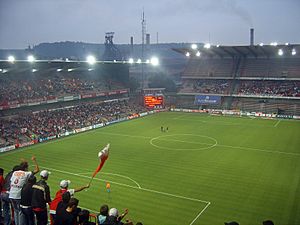
The city has several football (soccer) teams. The most famous is Standard Liège, which has won many championships. Another old club is R.F.C. de Liège. This club was involved in the Bosman ruling, a famous case that changed how football players can move between clubs.
In spring, Liège hosts the start and finish of the annual Liège–Bastogne–Liège cycling race. This is one of the oldest and most important "spring classics" in cycling. The race begins in central Liège, goes south to Bastogne, and then returns north to finish in the suburb of Ans. It travels through the hilly Ardennes region and is one of the longest and toughest races of the season.
Liège is the only city that has hosted stages of all three major cycling Grand Tours. It hosted the start of the 1973 and 2006 Giro d'Italia. It also hosted the Grand Départ (big start) of the 2004, 2012, and 2017 Tour de France. This makes it the first city outside France to host the Tour de France start more than once. In 2009, the Vuelta a España also visited Liège.
Liège is also home to boxer Ermano Fegatilli, who is a European champion in Super Featherweight boxing.
Liège Economy
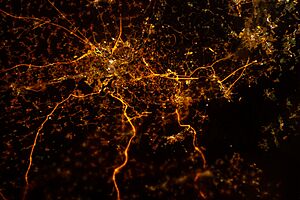
Liège is the most important city in the Walloon region for its economy. In the past, Liège was one of Europe's most important industrial centers, especially for steel-making. Starting in 1817, John Cockerill greatly developed the iron and steel industry. The industrial complex in Seraing was once the largest in the world. It had many blast furnaces and mills. Liège has also been a major center for making guns since the Middle Ages. The arms industry is still strong today, with the main offices of FN Herstal and CMI Defence located here. Even though the manufacturing sector has shrunk since 1960, making steel goods is still important.
The region's economy is now more varied. Key areas include mechanical industries (like Aircraft engine and Spacecraft propulsion), space technology, information technology, biotechnology, and producing water, beer, or chocolate. Liège has many high-tech companies, such as Techspace Aero, which makes parts for the Airbus A380 and the Ariane 5 rocket. Other notable companies include Amós, which makes optical parts for telescopes, and Drytec, which produces compressed air dryers. Liège also has many other electronics companies like SAP, EVS, Gillam, AnB, Balteau, and IP Trade. Other well-known businesses are the global leader in light weapons FN Herstal, the beer company Jupiler, the chocolate company Galler, and the water and soda companies Spa and Chaudfontaine. A science park south-east of the city, near the University of Liège campus, is home to new companies and high-tech businesses.
1812 Mine Rescue
In 1812, there were three coal mines just outside Liège. On February 28, 1812, a water pump failed in one mine, flooding it. Many miners were trapped. While some escaped, 74 men were stuck deep underground.
The trapped miners tried to dig their way to another mine. After digging some distance, they hit an old, abandoned mine. The overseer, Mr. Goffin, bravely led the men to a spot he thought was closest to a third mine, and they started digging again. They ran out of candles and dug the rest of the tunnel in complete darkness.
Above ground, rescuers worked hard to reach the trapped miners through the third mine. They dug as fast as they could, even using explosives. The trapped miners and rescuers could hear each other. Five days after the accident, they made contact. The rescuers worked in darkness to avoid gas explosions. By that evening, an opening was made. They had dug 511 feet of tunnel by hand in just five days! All 74 miners led by Mr. Goffin were saved and brought to the surface.
Getting Around Liège
Air Travel
Liège is served by Liège Airport, located a few kilometers west of the city in Bierset. This airport is mainly used for cargo (freight delivery). In 2011, it was the 33rd busiest cargo airport in the world. There are very few passenger flights. The airport is owned by the Walloon government and some private investors.
Water Travel
The Port of Liège, located on the Meuse River, is the third largest river port in Europe. Liège also has direct connections to Antwerp through the Albert Canal and to Rotterdam via the Meuse River. The port stretches over 26 kilometers and includes 32 port areas, covering 3.7 square kilometers.
Train Travel
Liège has many direct train connections to other parts of Western Europe. Its three main stations are Liège-Guillemins railway station, Liège-Carré, and Liège-Saint-Lambert. High-speed trains like the InterCity Express and Thalys stop at Liège-Guillemins. These trains offer direct links to Cologne and Frankfurt in Germany, and to Paris-Nord in France.
Liège once had a network of trams. However, they were removed by 1967. A new metro system was planned, and a prototype and tunnel were built, but the metro was never finished. A new modern tramway has been ordered, and the first tracks were laid in April 2021.
Road Travel
Liège is located at the meeting point of several major highways. These include the European route E25, the European Route E42, the European Route E40, and the European Route E313.
Famous People from Liège
- Alger of Liège (11th century), learned priest
- Nicolas Ancion (born 1971), writer
- Jacques Arcadelt (16th century), composer
- Nacer Chadli (born 1989), football player
- Charlemagne (birth in Liège uncertain, 8th century), King of the Franks, then crowned emperor
- Johannes Ciconia (14th century), composer, Master of the Ars Nova
- Steve Darcis, (born 1984), tennis player
- Jean d'Outremeuse (14th century), writer and historian
- Benoît Debie (born 1968), cinematographer
- Theodor de Bry (1528–1598), engraver
- Louis De Geer (1587–1652), introduced Walloon blast furnaces in Sweden
- Gérard de Lairesse (1640–1711), painter
- Jean-Maurice Dehousse (born 1936), politician, Walloon movement activist, first Minister-President of the Walloon Region
- Serge Delaive (born 1965), writer
- Marie Delcourt (1891–1979), professor at the University, expert of ancient Greek religion, Walloon movement activist
- Louis Dewis (1872–1946), pseudonym for the Post-Impressionist painter born Louis Dewachter, leading retailer who managed the first chain department stores
- Emile Digneffe (1858–1937), lawyer and politician
- José Dupuis (1833–1900), creator of many roles in Offenbach's opéras-bouffes
- Ermano Fegatilli (born 1984), boxer
- César Franck (1822–1890), composer
- Hubert Joseph Walther Frère-Orban (1812–1896), statesman
- Marie Gillain (born 1975), international actress
- David Goffin, (born 1990), tennis player
- Anton Gosswin (16th century), composer
- Zénobe Gramme (1826–1901), inventor
- André Ernest Modeste Grétry (1741–1813), composer
- Groupe μ, team of scientists
- Gary Hartstein, M.D. (born 1955), Formula 1 delegate
- Richard Heintz (1871–1929), Post-Impressionist painter
- Justine Henin (born 1982), top ranked female tennis player
- Axel Hervelle (born 1983), basketball player
- Georges Ista (1874–1939), writer
- Joseph Jongen (1873–1953), organist, composer, and educator
- Sandra Kim (born 1972), winner of the Eurovision Song Contest 1986 for Belgium
- Caroline Lamarche (born 1955), French-speaking writer
- Bouli Lanners (born 1965), actor, film director
- Philippe Léonard (born 1974), football player
- Linus of Liège (1595–1675), Counter-reformation critic of Isaac Newton
- Lambert Lombard (1505–1566), painter
- Charles Magnette (1863–1937), lawyer and politician
- Georges Malempré (1944), retired UNESCO official
- Georges Nagelmackers (1845–1905), founder of the Compagnie Internationale des Wagons-Lits
- Hubert Naich (16th century), composer
- Jacques Ochs (1883–1971), artist and Olympic fencing champion
- Pippin the Younger (in French: Pépin le Bref; born in Jupille, 8th century), King of the Franks
- Henri Pousseur (1929–2009), composer
- Armand Rassenfosse (1862–1934), painter, graphic artist
- Jean Rey (1902–1983), Old Minister, Walloon movement activist second President of the European Commission
- Philippe-Charles Schmerling, prehistorian, founder of paleontology
- Gustave Serrurier-Bovy (1858–1910), architect and furniture designer
- Georges Simenon (1903–1989), novelist
- Stanislas-André Steeman (1908–1970), writer
- Haroun Tazieff (1914–1998), volcanologist and geologist
- William of St-Thierry (11th century), theologian and mystic
- Violetta Villas (1938–2011), Polish singer and actress
- Axel Witsel (born 1989), football player
- Eugène Ysaÿe (1858–1931), composer and violinist
Liège's International Connections
Liège is twinned with many cities around the world. This means they have special friendly relationships.
Sister Cities
 Nancy, France (1954)
Nancy, France (1954) Cologne, Germany (1958)
Cologne, Germany (1958) Esch-sur-Alzette, Luxembourg (1958)
Esch-sur-Alzette, Luxembourg (1958) Lille, France (1958)
Lille, France (1958) Rotterdam, Netherlands (1958)
Rotterdam, Netherlands (1958) Turin, Italy (1958)
Turin, Italy (1958) Lubumbashi, Democratic Republic of the Congo (1961)
Lubumbashi, Democratic Republic of the Congo (1961) Plzeň, Czech Republic (1965)
Plzeň, Czech Republic (1965) Porto, Portugal (1977)
Porto, Portugal (1977) Kraków, Poland (1978)
Kraków, Poland (1978) Saint-Louis, Senegal (1980)
Saint-Louis, Senegal (1980) Szeged, Hungary (2001)
Szeged, Hungary (2001) Volgograd, Russia (1959) (This partnership is currently paused.)
Volgograd, Russia (1959) (This partnership is currently paused.)
Partner Cities
 Aachen, Germany
Aachen, Germany Abidjan, Ivory Coast
Abidjan, Ivory Coast Baton Rouge, United States
Baton Rouge, United States Bilbao, Spain
Bilbao, Spain Elbasan, Albania
Elbasan, Albania Hasselt, Belgium
Hasselt, Belgium Heerlen, Netherlands
Heerlen, Netherlands Maastricht, Netherlands
Maastricht, Netherlands Port-au-Prince, Haiti
Port-au-Prince, Haiti Ramallah, Palestine
Ramallah, Palestine Quebec City, Canada
Quebec City, Canada Samarkand, Uzbekistan
Samarkand, Uzbekistan Taiyuan, China
Taiyuan, China Tangier, Morocco
Tangier, Morocco
See Also
In Spanish: Lieja para niños







